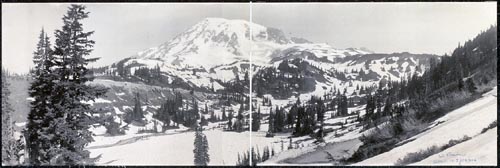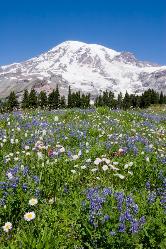Mount Rainier National Park - Historical Perspective
From Famous Conservationist, John Muir: "If in the making of the West, Nature had what we
call parks in mind, —places for rest, inspiration, and prayers, —this Rainier region must surely be
one of them." John Muir, Our National Parks (1901), page 30.
Mt. Rainier, Mt. Rainier National Park, Washington, circa 1925.
On March 2, 1899, President William McKinley signed legislation creating Mount Rainier National
Park in central Washington. The 365-square-mile area of pristine forests and spectacular alpine
scenery was the fourth national park designated by Congress after Yellowstone, Yosemite &
Sequoia.
Called Tacoma (or Tahoma) by generations of Northwest Native Americans, Mount Rainier was
named after Admiral Peter Rainier in 1792 by English explorer George Vancouver, who sighted
the enormous 14,410-foot volcanic peak while exploring Puget Sound.
Nearly a century later, famed naturalist John Muir visited the Rainier region and later
recommended that it be designated as a national park. Muir was impressed with the magnificent
wildflowers that blanket the mountain during the warm months of the year. In his 1898 essay
"The Wild Parks and Forest Reservations of the West," reprinted in his 1901 book Our National
Parks, Muir wrote:
From Famous Conservationist, John Muir: "If in the making of the West, Nature had what we
call parks in mind, —places for rest, inspiration, and prayers, —this Rainier region must surely be
one of them." John Muir, Our National Parks (1901), page 30.
Mt. Rainier, Mt. Rainier National Park, Washington, circa 1925.
On March 2, 1899, President William McKinley signed legislation creating Mount Rainier National
Park in central Washington. The 365-square-mile area of pristine forests and spectacular alpine
scenery was the fourth national park designated by Congress after Yellowstone, Yosemite &
Sequoia.
Called Tacoma (or Tahoma) by generations of Northwest Native Americans, Mount Rainier was
named after Admiral Peter Rainier in 1792 by English explorer George Vancouver, who sighted
the enormous 14,410-foot volcanic peak while exploring Puget Sound.
Nearly a century later, famed naturalist John Muir visited the Rainier region and later
recommended that it be designated as a national park. Muir was impressed with the magnificent
wildflowers that blanket the mountain during the warm months of the year. In his 1898 essay
"The Wild Parks and Forest Reservations of the West," reprinted in his 1901 book Our National
Parks, Muir wrote:
- "…above the forests there is a zone of the loveliest flowers, fifty
miles in circuit and nearly two miles wide, so closely planted and
luxuriant that it seems as if Nature, glad to make an open space
between woods so dense and ice so deep, were economizing the
precious ground, and trying to see how many of her darlings she
can get together in one mountain wreath, —daisies, anemones,
geraniums, columbines, erythroniums, larkspurs, etc., among
which we wade knee-deep and waist-deep, the bright corollas in
myriads touching petal to petal. "
That is quite a statement towards the historical beauty of Mount
Rainier.
| RainierVisitorGuide.com Information Resource Center |
Mount Rainier History

| . |
Home
..
Mt. Rainier:
.
• Visitor Centers
• Recreation
• Lodging - Motels
• Lodging - Inns - B&B
• Lodging - Cabins
• Camping / RV Parks
• Shopping
• Rainier Cam
• Restaurants
• Climb Rainier
• Hike Rainier
• Bike Rainier
• Rainier Maps
• Satellite Map
• 360° Rainier View
• Photo Gallery
• Photography
• Videos
• Travel Links
• Fun Facts - History
• Rainier News
• Mt. St. Helens
..
Mt. Rainier:
.
• Visitor Centers
• Recreation
• Lodging - Motels
• Lodging - Inns - B&B
• Lodging - Cabins
• Camping / RV Parks
• Shopping
• Rainier Cam
• Restaurants
• Climb Rainier
• Hike Rainier
• Bike Rainier
• Rainier Maps
• Satellite Map
• 360° Rainier View
• Photo Gallery
• Photography
• Videos
• Travel Links
• Fun Facts - History
• Rainier News
• Mt. St. Helens
For more book selections see our Mount Rainier Bookstore
